Abstract
Exposure of C3H 10T1/2 Cl 8 cells, synchronized by release from confluence-induced arest of proliferation, to different concentrations of N-methyl-N'-nitro-N-nitrosoguanidine (MNNG) for 30 min at various points during the cell cycle causes dose-dependent toxicity (decrease in relative colony-forming efficiency or "survival") that increases linearly during the first G1 phase, reaches a maximum in early to middle S phase, and decreases during late S. In the course of the second S phase, toxicity again becomes maximal. The transformation rate (type III foci) increases and decreases with a similar pattern, increasing during the first G1 phase to a maximum during early S phase, subsequently decreasing, and then increasing again during the second S phase. Although periods of maximal toxicity and transformation roughly coincide with some portion of the S phase, the mechanisms underlying these phenomena appear to differ for the following reasons: (a) toxicity is linearly related to dose of MNNG, whereas the latter is linearly related to the logarithm of transformation rate, and (b) the ratio between toxicity and transformation varies with the cycle phase and the dose of MNNG.
Full text
PDF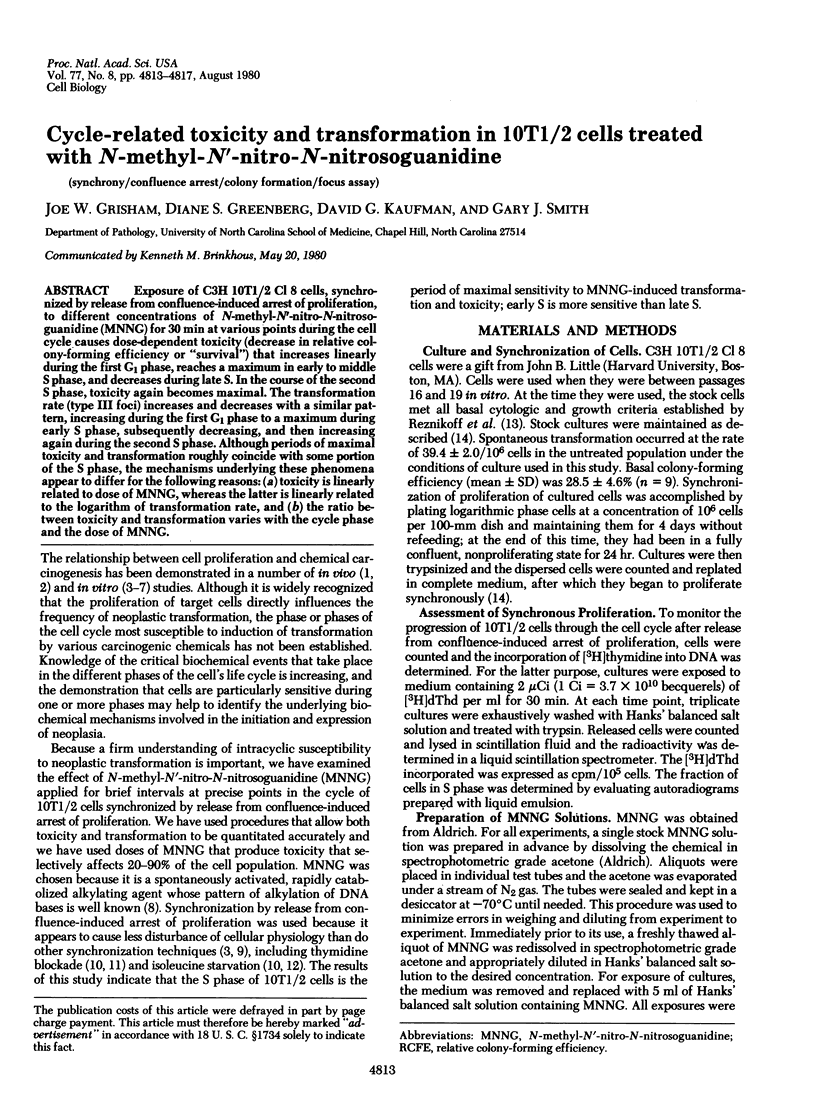
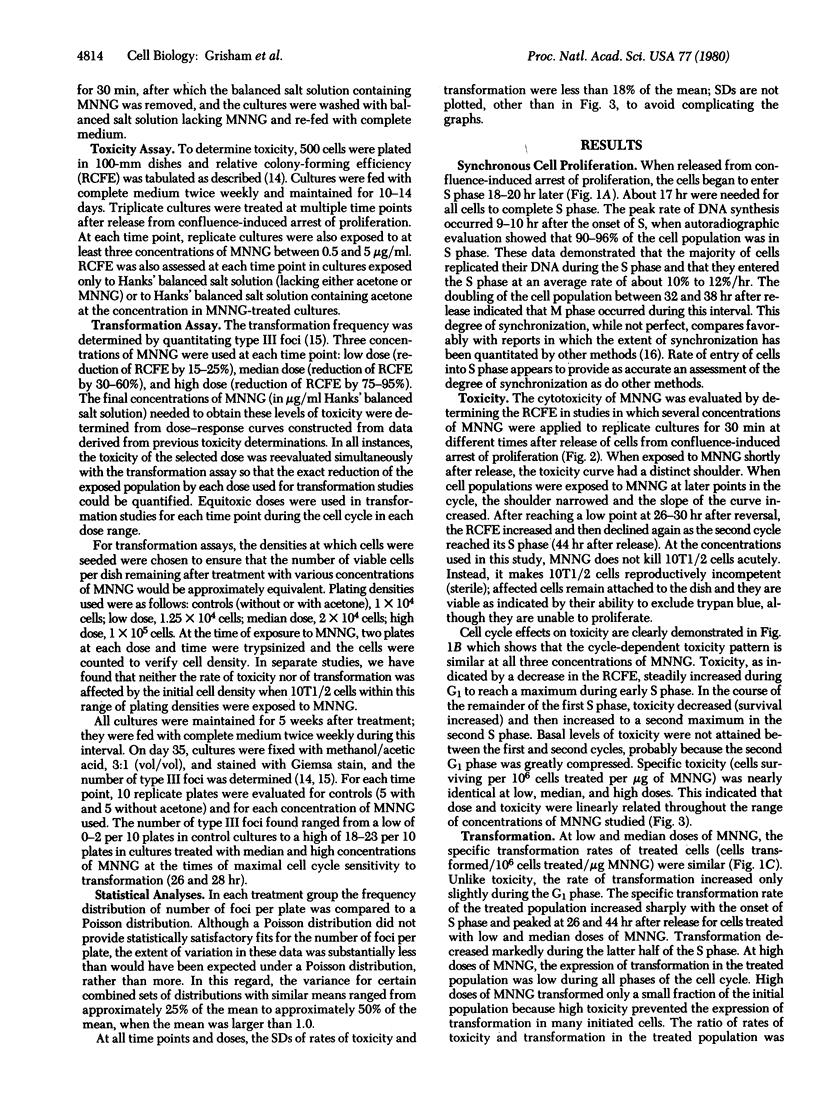
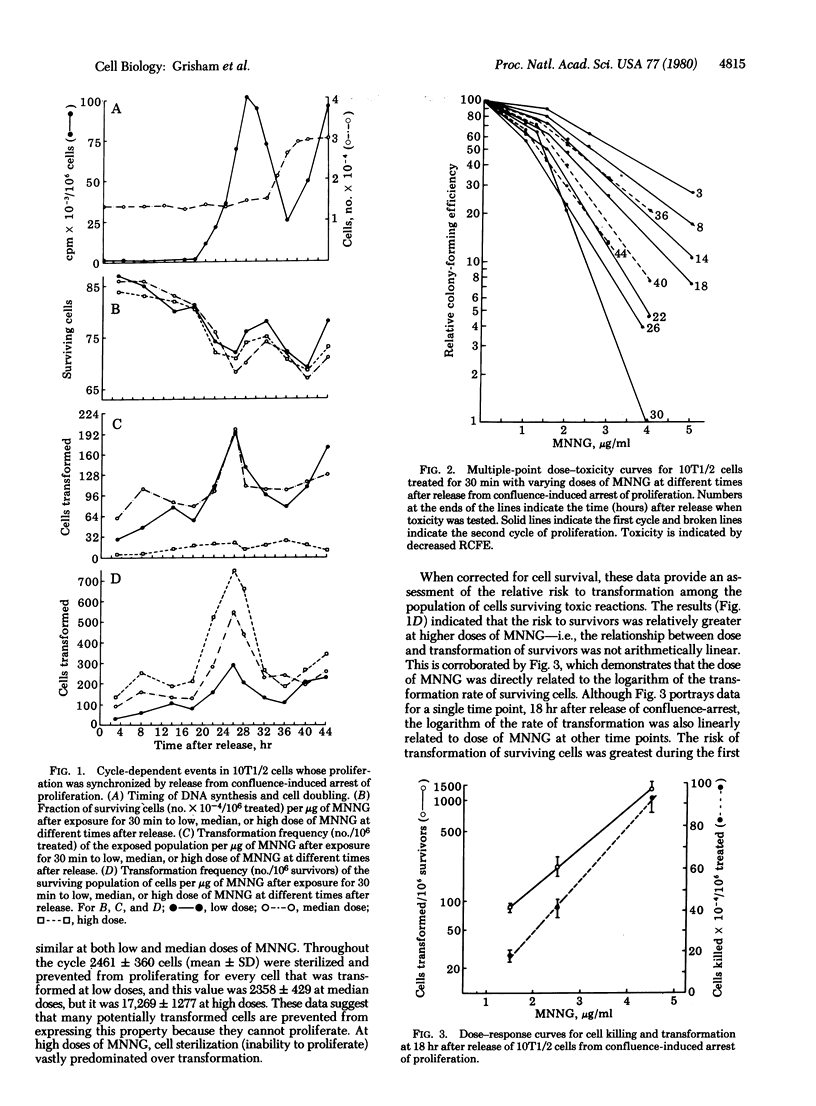
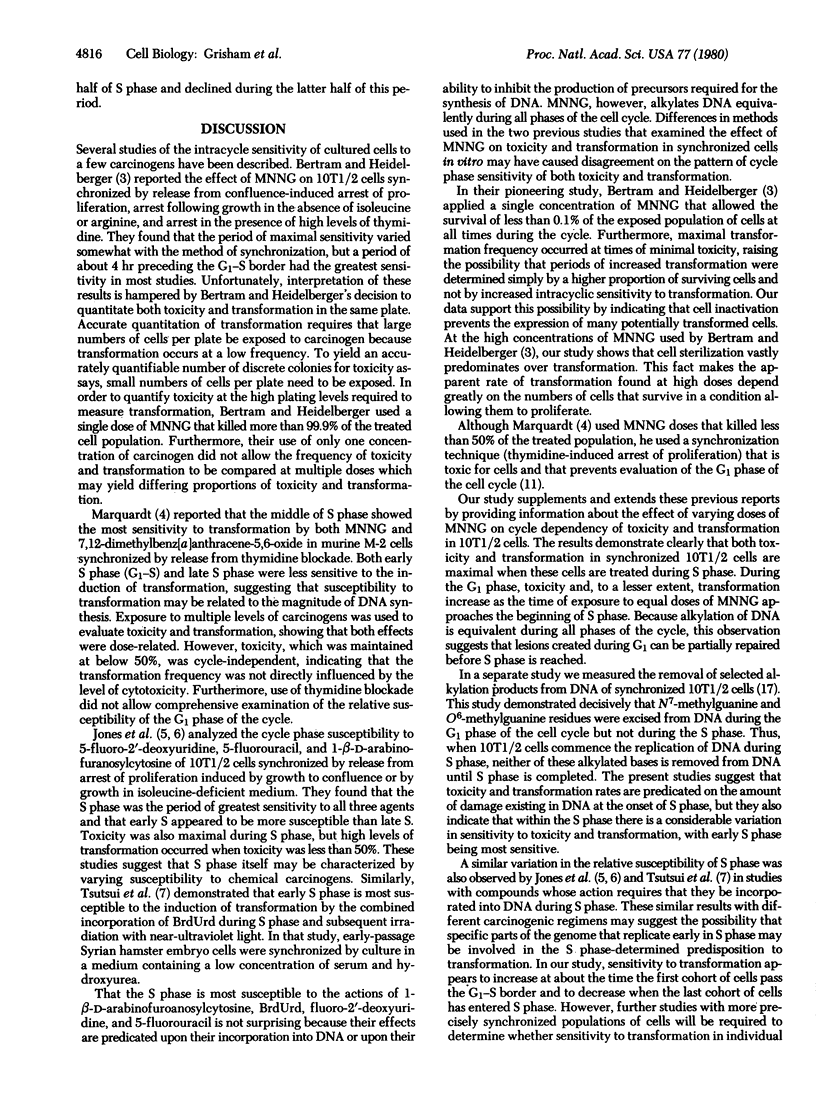
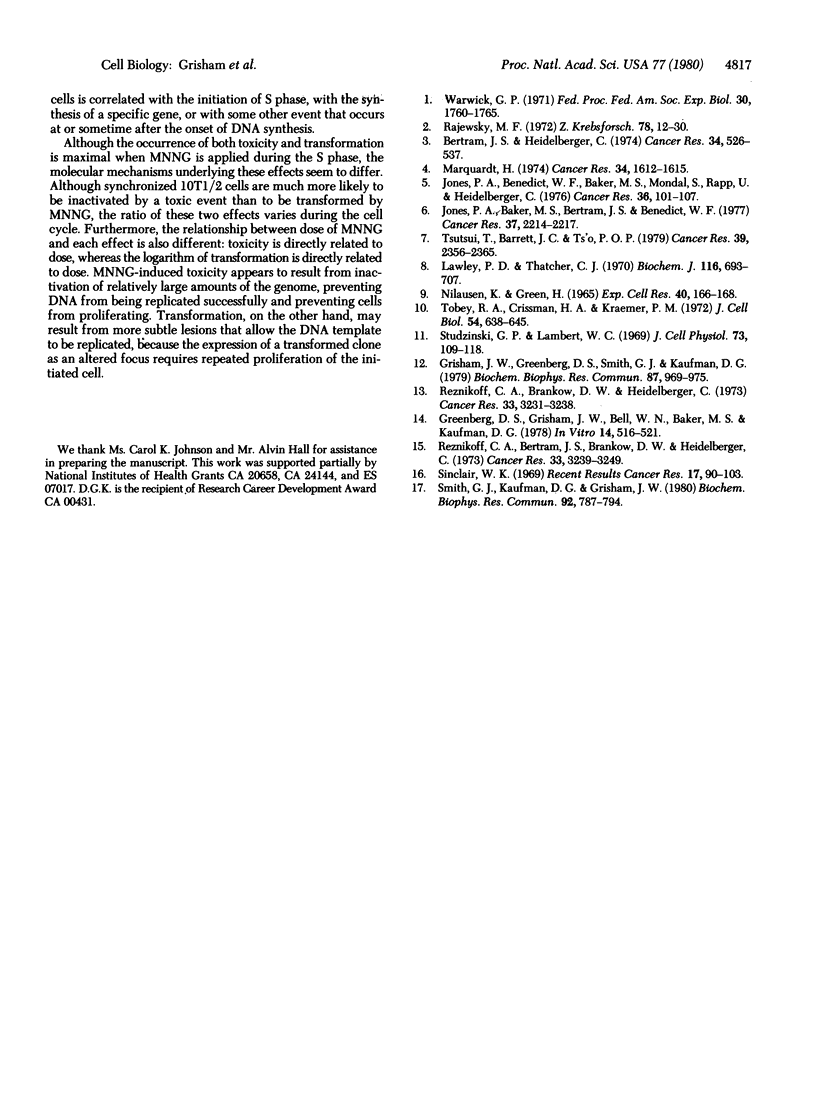
Selected References
These references are in PubMed. This may not be the complete list of references from this article.
- Bertram J. S., Heidelberger C. Cell cycle dependency of oncogenic transformation induced by N-methyl-N'-nitro-N-nitrosoquanidine in culture. Cancer Res. 1974 Mar;34(3):526–537. [PubMed] [Google Scholar]
- Greenberg D. S., Grisham J. W., Bell W. N., Baker M. S., Kaufman D. G. Differing effects of isoleucine deficiency on the toxicity of MNNG for 10T1/2 and CHO cells. In Vitro. 1978 Jun;14(6):516–521. doi: 10.1007/BF02616093. [DOI] [PubMed] [Google Scholar]
- Grisham J. W., Greenberg D. S., Smith G. J., Kaufman D. G. Temporary culture in isoleucine-free medium enhances transformation of 10T1/2 cells by N-methyl-N'-nitro-N-nitrosoguanidine (MNNG). Biochem Biophys Res Commun. 1979 Apr 27;87(4):969–975. doi: 10.1016/s0006-291x(79)80001-7. [DOI] [PubMed] [Google Scholar]
- Jones P. A., Baker M. S., Bertram J. S., Benedict W. F. Cell cycle-specific oncogenic transformation of C3H/10T1/2 clone 8 mouse embryo cells by 1-beta-D-arabinofuranosylcytosine. Cancer Res. 1977 Jul;37(7 Pt 1):2214–2217. [PubMed] [Google Scholar]
- Jones P. A., Benedict W. F., Baker M. S., Mondal S., Rapp U., Heidelberger C. Oncogenic transformation of C3H/10T1/2 clone 8 mouse embryo cells by halogenated pyrimidine nucleosides. Cancer Res. 1976 Jan;36(1):101–107. [PubMed] [Google Scholar]
- Lawley P. D., Thatcher C. J. Methylation of deoxyribonucleic acid in cultured mammalian cells by N-methyl-N'-nitro-N-nitrosoguanidine. The influence of cellular thiol concentrations on the extent of methylation and the 6-oxygen atom of guanine as a site of methylation. Biochem J. 1970 Feb;116(4):693–707. doi: 10.1042/bj1160693. [DOI] [PMC free article] [PubMed] [Google Scholar]
- Marquardt H. Cell cycle dependence of chemically induced malignant transformation in vitro. Cancer Res. 1974 Jul;34(7):1612–1615. [PubMed] [Google Scholar]
- Nilausen K., Green H. Reversible arrest of growth in G1 of an established fibroblast line (3T3). Exp Cell Res. 1965 Oct;40(1):166–168. doi: 10.1016/0014-4827(65)90306-x. [DOI] [PubMed] [Google Scholar]
- Rajewsky M. F. Proliferative parameters of mammalian cell systms and their rôle in tumor growth and carcinogenesis. Z Krebsforsch Klin Onkol Cancer Res Clin Oncol. 1972;78(1):12–30. doi: 10.1007/BF00284309. [DOI] [PubMed] [Google Scholar]
- Reznikoff C. A., Bertram J. S., Brankow D. W., Heidelberger C. Quantitative and qualitative studies of chemical transformation of cloned C3H mouse embryo cells sensitive to postconfluence inhibition of cell division. Cancer Res. 1973 Dec;33(12):3239–3249. [PubMed] [Google Scholar]
- Reznikoff C. A., Brankow D. W., Heidelberger C. Establishment and characterization of a cloned line of C3H mouse embryo cells sensitive to postconfluence inhibition of division. Cancer Res. 1973 Dec;33(12):3231–3238. [PubMed] [Google Scholar]
- Smith G. J., Kaufman D. G., Grisham J. W. Decreased excision of O6-methylguanine and N7-methylguanine during the S phase in 10T1/2 cells. Biochem Biophys Res Commun. 1980 Feb 12;92(3):787–794. doi: 10.1016/0006-291x(80)90772-x. [DOI] [PubMed] [Google Scholar]
- Studzinski G. P., Lambert W. C. Thymidine as a synchronizing agent. I. Nucleic acid and protein formation in synchronous HeLa cultures treated with excess thymidine. J Cell Physiol. 1969 Apr;73(2):109–117. doi: 10.1002/jcp.1040730204. [DOI] [PubMed] [Google Scholar]
- Tobey R. A., Crissman H. A., Kraemer P. M. A method for comparing effects of different synchronizing protocols on mammalian cell cycle traverse. The traverse perturbation index. J Cell Biol. 1972 Sep;54(3):638–645. doi: 10.1083/jcb.54.3.638. [DOI] [PMC free article] [PubMed] [Google Scholar]
- Tsutsui T., Barrett J. C., Ts'o P. O. Morphological transformation, DNA damage, and chromosomal aberrations induced by a direct DNA perturbation of synchronized Syrian hamster embryo cells. Cancer Res. 1979 Jul;39(7 Pt 1):2356–2365. [PubMed] [Google Scholar]
- Warwick G. P. Effect of the cell cycle on carcinogenesis. Fed Proc. 1971 Nov-Dec;30(6):1760–1765. [PubMed] [Google Scholar]


